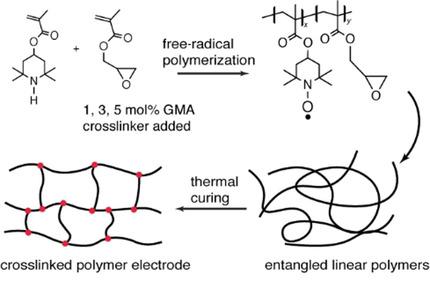当前位置:
X-MOL 学术
›
ChemSusChem
›
论文详情
Our official English website, www.x-mol.net, welcomes your
feedback! (Note: you will need to create a separate account there.)
Solution-Processable Thermally Crosslinked Organic Radical Polymer Battery Cathodes.
ChemSusChem ( IF 7.5 ) Pub Date : 2020-03-05 , DOI: 10.1002/cssc.201903554 Shaoyang Wang 1 , Albert Min Gyu Park 2 , Paraskevi Flouda 3 , Alexandra D Easley 3 , Fei Li 1 , Ting Ma 1 , Gregory D Fuchs 2 , Jodie L Lutkenhaus 1, 3
ChemSusChem ( IF 7.5 ) Pub Date : 2020-03-05 , DOI: 10.1002/cssc.201903554 Shaoyang Wang 1 , Albert Min Gyu Park 2 , Paraskevi Flouda 3 , Alexandra D Easley 3 , Fei Li 1 , Ting Ma 1 , Gregory D Fuchs 2 , Jodie L Lutkenhaus 1, 3
Affiliation

|
Organic radical polymers are promising cathode materials for next-generation batteries because of their rapid charge transfer and high cycling stability. However, these organic polymer electrodes gradually dissolve in the electrolyte, resulting in capacity fade. Several crosslinking methods have been developed to improve the performance of these electrodes, but they are either not compatible with carbon additives or compromise the solution processability of the electrodes. A one-step post-synthetic, carbon-compatible crosslinking method was developed to effectively crosslink an organic polymer electrode and allow for easy solution processing. The highest electrode capacity of 104 mAh g-1 (vs. a theoretical capacity of 111 mAh g-1 ) is achieved by introducing 1 mol % of the crosslinker, whereas the highest capacity retention (99.6 %) is obtained with 3 mol % crosslinker. In addition, mass transfer was observed in situ by using electrochemical quartz crystal microbalance with dissipation monitoring. These results may guide future electrode design toward fast-charging and high-capacity organic electrodes.
中文翻译:

可溶液处理的热交联有机自由基聚合物电池阴极。
有机自由基聚合物因其快速的电荷转移和高的循环稳定性而成为下一代电池的正极材料。然而,这些有机聚合物电极逐渐溶解在电解质中,导致容量衰减。已经开发了几种交联方法来改善这些电极的性能,但是它们与碳添加剂不相容或损害电极的溶液可加工性。开发了一种一步合成后的碳相容性交联方法,可有效地交联有机聚合物电极并易于溶液加工。通过引入1 mol%的交联剂可实现104 mAh g-1的最高电极容量(相对于111 mAh g-1的理论容量),而最高的容量保持率(99。用3mol%的交联剂获得6%)。此外,通过使用电化学石英晶体微量天平进行耗散监测,就地观察到了传质。这些结果可以指导未来的电极设计朝着快速充电和高容量的有机电极发展。
更新日期:2020-03-05
中文翻译:

可溶液处理的热交联有机自由基聚合物电池阴极。
有机自由基聚合物因其快速的电荷转移和高的循环稳定性而成为下一代电池的正极材料。然而,这些有机聚合物电极逐渐溶解在电解质中,导致容量衰减。已经开发了几种交联方法来改善这些电极的性能,但是它们与碳添加剂不相容或损害电极的溶液可加工性。开发了一种一步合成后的碳相容性交联方法,可有效地交联有机聚合物电极并易于溶液加工。通过引入1 mol%的交联剂可实现104 mAh g-1的最高电极容量(相对于111 mAh g-1的理论容量),而最高的容量保持率(99。用3mol%的交联剂获得6%)。此外,通过使用电化学石英晶体微量天平进行耗散监测,就地观察到了传质。这些结果可以指导未来的电极设计朝着快速充电和高容量的有机电极发展。











































 京公网安备 11010802027423号
京公网安备 11010802027423号